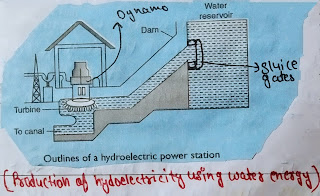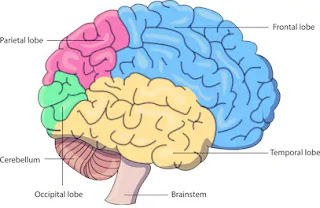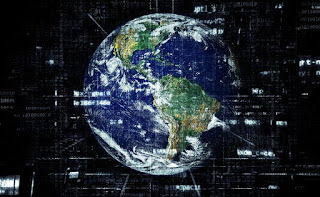Sources of energy notes science||Cbse notes class-10th science
Source of Energy Notes
•Energy comes in different forms and one form can be converted into another.
•A source of energy is one which provide adequate amount of energy in a convenient form over a long period of time.
Need of energy:
•For making Food.
•For lightening .
•For transport .
•For running machines.
•For industrial activities and agricultural work.
Qualities of a Good Source of energy
1.which would do a large amount of work per unit mass.
2.Cheap and easily available.
3.Easy to store and transport.
4.Safe to handle and use.
5.Does not cause environmental pollution.
Fuels:The materials which are burn to produce heat energy are known
as Fuels E.g wood, cool, LPG, Kerosence.
Characteristics of a good fuel
•High calorific value (give more heat per unit mass).
•Burn without giving out any smoke or harmful gases.
•Proper ignition temperature
•cheap and easily available
•Easy to handle , safe to transport.
•Convenient to store.
•Burn smoothly.
Source of energy
Conventional sources of energy
→Fossil Fuels (coal, Petroleum)
→Thermal Power plant
→Hydro power plants
→Geothermal energy
Non-conventional sources of energy
→solar energy (eg;Solar cooker, solar cell panel)
→Biomass-biogas plant
→wind energy
→Nuclear energy
→Energy from the sea(Tidal wave, OT energy)
Conventional sources of energy
Sources of energy which are known to most of the people.Eg Fossil fuels,biomass etc.
I Fossile Fuels:
•Fuels developed from the fossils eg;Coal, petroleum.
•Take millions of year's to form.
•Available in very limited amount.
•These are non-renewable sources of energy.
India has about 6℅ share in the world reserved coal, that may last 250 years more at the present rate of consumption.
Pollution caused by Fossil fuels
•Relased oxides of carbon, nitrogen and sulphur (acidic in nature)which caused acid rain that damages trees, plants, reduces fertility of soil.
•Produces large amount of Co² in the atmosphere which cause green house effect leading to excessive heating of the earth.
Control Pollution caused by Fossil Fuels
•Increasing the efficiency of the Combustion process.
•Using various techniques to reduce the escape of harmful gases and ashes into the surroundings.
II Thermal Power Plant:
A power plant which uses heat energy to generate electricity.
•Burning of fossile fuels produces steam to run turbines.
•Set up(power plants) near the coal and oil fields to minimize the cost of transportation and production.
•Transmission of electricity is more efficient.
III Hydro Power Plants:
•Convert the potential energy of falling water into electricity.
•Hydro power plants are associated with dams around 25℅ of our country's energy requirement is med by hydro power plants.
Advantages:
(i)No environmental pollution.
(ii)Flowing water is a renewable source of electric energy.
(iii)Construction of dams prevents flooding of rivers , provide water for irrigation.
Disadvantages:
(i)large areas of agricultural land , a vast variety of flora and fauna, human settlements get submerged in the water of reservoir formed by the dam.
(ii)large ecosystem are destroyed.
(iii)vegetation that submerged under water rods under anaerobic conditions and produces large amount of methane which is a green house gas.
(iv)Create the problems of satisfactory rehabilitation of displaced people.
Improvements in the technology for Using Conventional sources of energy
I Biomass:
The dead parts of and trees and the waste materials of animals and man are called biomass.
(i)wood:It is a biomass and used as a fuel for a long time.
Disadvantages:
•Produces a lot of smoke on burning.
•Do not produce much heat.
•Thus by improvement in technology we can improve the efficiency of traditional sources of energy.for eg; wood can be converted into much better fuel called charcoal.
(II)Charcoal:when woos is burnt in limited supply of air then water and other volatile materials gets removed and charcoal is formed.
wood limited supply of O² charcoal
—————————›
Charcoal is better fuel than wood because:
(1)It has higher calorific value than wood.
(2)Does not produce smoke while burning.
(3)It is a compact fuel, easy to handle and convenient to use.
(III)Cow dung:It is biomass but it is not good to burn cow dung directly as fuel because:
•Produces lot of smoke.
•Cowdungs does not burn completely , produces lot of ash as reside.
•low Calorific value.
•By making biogas (or gobar gas)from cow dung, we get a smokeless fuel.
(IV)Biogas:
It is produced in a biogas plant.Anaeobic microorganisms decomposes the complex compound of the cow dung+water slurry.It takes few day for the decomposition process and generate gases like methane , Co², hydrogen and hydrogen sulphide.Biogas is stored in the gas tank above the digester from which they are drawn through pipes for use.
Advantages of Biogas:
(i)It is an excellent fuel as it contains upto 75℅ methane(CH⁴).
(ii)It burns without smoke.
(iii)leaves no residue like ash in wood and coal burning.
(iv)Heating capacity is high.
(v)It is also used for lighting.
(vi)Slurry left behind is used as excellent manure rich in nitrogen and phosphorus.
(vii)Safe and efficient method of waste disposal.
(v)wind energy:
Unequal heating of the landmass and water bodies by solar radiations generate air movement and causes wind to blow.
•kinetic energy of the wind can be used:
•To generate electricity by turning the motor of the turbine.
•To lift water from the well.
•To run the flour mills.
→But the output of a single windmill is quite small so a number of windmills are exected over a large area called wind energy farm.
→The minimum wind speed for windmill to serve as a source of energy is 15-20km PH.
Advantage:
(i)Eco-friendly
(ii)Efficient source of renewable energy.
(iii)No recurring expenses for production of electricity.
Disadvantage:
(I)wind energy farms need large area of land.
(II)Difficulty in getting regular wind speed of 15-20 kmPH.
(III)Initial cost of establishing wind energy farm is very high.
(IV)High level of maintenance of blades of wind mill.
→Denmark is called the ' country of winds'.
→India is ranked 5th harnessing wind energy for the production of electricity.
→In India largest wind energy farm has been established near kanyakumari in Tamil Nadu and it generates 380 MW electricity.
Alternate or Non-Conventional sources of energy
Day by day , our demand for energy increases, so there is a need for another source of energy.
Reason for alternate sources of energy
(i)The fossil fuel reserves in the earth are limited which may get exhausted soon if we use them at the current rate.
(ii)Reduce the pressure on fossil fuels making them last for a much longer time.
(iii)To reduce the pollution level and to save the environment.
I Solar Energy:
•Sun is the ultimate source of energy.
•Energy obtained from the sun is called solar energy.
Solar constant=1.4kJk/m²
Outer edge of the earth receives solar energy equal to 1.4kJ/s/m² or 1.4kw/m²[...1kJ/s=1kw]
Solar energy devices:Decices using solar energy are:
(I)Solar cooker
(II)Solar water heater
(III)Solar cells
Solar heating devices
•Use of glass plate because it Allows infrared radiation to enter through but does not allow the radiation to exit through it, causing more green house effect that result in increase in temperature.
(I) Solar Cooker
Box type solar cooker:It consists of a rectangle box which is made up of wood or plastic which is painted dull black.
•Inner walls of the box are painted black to increase heat absorption.
•Solar cookr are covered with glass plate and have mirror to focus the rays of the sun and achieve higher temperature.
•Temperature insidee the box increases 100°C-140°C in 2-3 hours.
Advantages:
(a)save precious fuel like coal, LPG, Kerosene.
(b)Does not produce smoke.
(C)Nutrients of food do not get destroyed while cooking
(d)Upon four items can be cooked at the same time.
Disadvantages:
(a)Solar cookers cannot be used during night.
(b)If the day sky is covered with clouds even then solar cooker cannot be used.
(c)Direction of reflector of solar cooker changes from time to time to keep it facing the sun.
(d)Cannot be used for frying or banking purpose.
II Solar Cell:
•Solar cells convert solar energy into electricity.
•A solar celll develops a voltage of 0.5-1V and can produce about 0.7w of electricity.
•A large number of solar cell are combined in an arrangement called solar cell panel.
Advantages:
(a)Have no moving parts.
(b)Require little maintenance.
(c)Can work without any focusing device.
(d)Can be set up in remote and inaccessible areas.
Disadvantages:
(a)Manufacturing is expensive .
(b)Availability If special grade silicon
For making solar cells is limited.
(c)Silver wire for interconnection of cell is expensive.
Use of solar cell:
(a)Artificial satellites and space probes use solar cells as the main source of energy.
(b)Radio , Tv relay stations in remote locations use solar cell panels.
(c)Traffic signals , calculators and many toys are fitted with solar cells.
III. Energy From the Sea
Tidal Energy (working)
The phenomenon of high and low tide give us tidal energy .
(ii)It is harnessed by constructing a dam across the narrow opening of the sea.
Wave Energy (working)
Kinetic energy of huge waves near sea shore is trapped to generate electricity.wave energy is used for rotation of turbine and production of electricity.wave energy is used for rotation of turbine and production of electricity.
Ocean thermal Energy(working)
The difference in the temperature of water at the surface and deeper section of ocean is used to obtain energy in ocean thermal energy conversion plants.(OTEC).The warm surface water is used to boil volatile liquid ammonia .The vapours of liquid are used to run the turbine of generator to produce electricity.
Disadvantages of Tidal energy, wave energy, Ocean thermal energy
Tidal energy:
The location where such dams can be built are limited.
Wave energy:
wave energy is viable only where waves are very strong.
Ocean thermal energy:
Efficient commercial exploitation is very difficult.
Geothermal Energy
•'Geo' means earth and 'thermal ' means heat.
•Geothermal energy is the heat energy from hot rocks present inside the earth .
•when underground water comes in contact with 'hot spot',steam is generated.Steam trapped in rocks is routed in rocks is routed through pipes to a turbine and used to generate electricity.
Advantages:
(a)Economical to use geothermal energy.
(b)Does not cause and pollution.
Limitations:
•Geothermal energy is not available everywhere.
•Deep drilling in earth to obtain geothermal energy is very difficult and expensive.
•In new Zealand and USA there are no, of power plants based on geothermal energy are operational.
Nuclear Energy
•The energy released during a nuclear reaction is called nuclear energy.
•It can be obtained by two types of Nuclear reaction:
(a)Nuclear Fission
(b)Nuclear Fusion
(I)Nuclear Fission:
•'Fission' means spilt up.
•The process in which the heavy nuclear of a radioactive atom(such as uranium, Plutonium or thorium)spilt up into smaller nuclei when bombored with low energy neutrons , is called nuclear fission.
•A tremendous amount of energy is produced.
•U-235 is used as a fuel in nuclear reactor in form of Uranium rods.
Working:In nuclear reactor self sustaining chain reaction releases energy at a controlled rate,which is used to produce steam and futher generate electricity.
Major Nuclear Power Plants:
(a)Tarapur(Maharashtra)
(b)Rana pratap sagar (Rajasthan)
(c)Kalpakkam(Tamil Nadu)
(d)Narora(uttar Pradesh)
(e)kakrapar(Gujrat)
(F)kaiga (Karnataka)
(ii)Nuclear Fusion:
When two nuclei of light elements(like hydrogen)combine to form a heavy nuclear(like nelium)and tremendous amount of energy is released is called nuclear fusion..
2/1 H(deuterium)+2/1H Fusion 3/2 He+1/O n+ Heat.
•very -very high temperature and pressure is needed for fusion.
•Hydrogen bomb is based on this phenomenon.
•Nuclear fusion is the source of energy in the sun and other stars.
Advantage:
(a)Production of large amount of useful energy from a small amount of nuclear fuel.
(b)Does not produce green house gases like Co².
Limitations:
(a)Environment Contamination due to improper nuclear waste storage and its disposal.
(b)Risk of accidental leakage of harmful radiations.
(c)High cost of installation.
(d)limited availability of nuclear fuel.
Environmental consequences
Exploiting any source of energy disturbs the environment in some way or the other.Thus , the source we would choose depends upon following the factors:
(a)Each of extracting energy from the source .
(b)Cost of extracting energy from the source.
(c)Efficiency of technology available to extract energy.
(d)The environmental damage caused by using that source.
In other words, no source of energy is said to pollution free.Some source are cleaner than the other.
For example , solar cells may be pollution free but the assembly of the device would have cause some environmental damage.
How long will an energy resource last us?
Sources of energy
Non-renewable sources of energy
Sources that will get depleted someday.
For example:Fossil fuel
Renewable sources of energy
Energy sources that can be regenerated and that will last for ever,
For example:wind energy, water energy.









Comments
Post a Comment
Use the respectfully words in comment box.